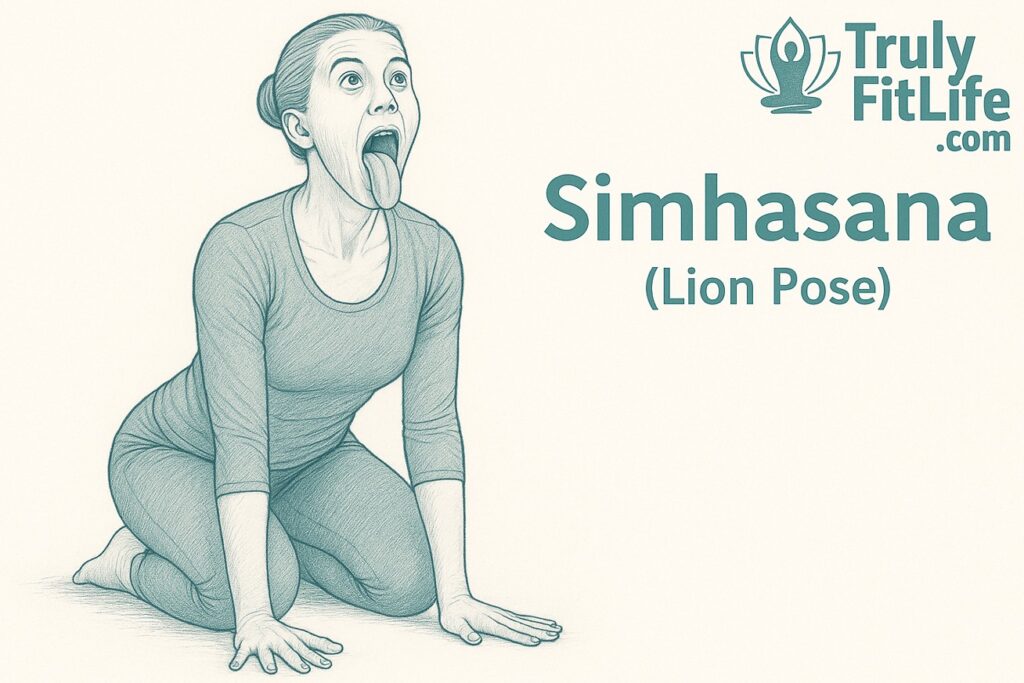
Simhasana (Lion Pose) is a unique seated yoga posture combined with a powerful breathing technique. The name comes from Sanskrit: “Simha” means lion, and “Asana” means pose. While most yoga postures emphasize stillness and subtle breathing, Simhasana is distinctive—it involves an energetic exhalation with the tongue extended and eyes wide open, resembling a roaring lion.
This asana is not only symbolic of courage and self-expression but also works deeply on the throat, face, and respiratory system. It relieves mental stress, removes suppressed emotions, and improves confidence. Because it is easy to perform, it is considered beginner-friendly and is often taught in children’s yoga classes as well.
Step-by-Step Instructions to Practice Simhasana – Lion Pose
1. Starting Position
- Sit on your yoga mat in Vajrasana (Thunderbolt Pose) or Padmasana (Lotus Pose).
- Keep spine erect and palms resting on thighs.
2. Hand Placement
- Lean slightly forward.
- Place palms on knees with fingers spread wide, pressing firmly downward.
3. Face & Mouth Position
- Open your mouth wide.
- Stick your tongue out fully, pointing it toward the chin.
4. Breathing Technique
- Inhale deeply through the nose.
- Exhale forcefully through the mouth while making a roaring sound like a lion.
5. Eyes & Gaze
- During exhalation, open eyes wide.
- Direct your gaze either at the tip of the nose (Nasagra Drishti) or between the eyebrows (Bhrumadhya Drishti).
6. Duration
- Repeat 3–5 rounds initially.
- With practice, increase to 10 rounds.
Alignment Tips
- Keep spine tall, chest open, and shoulders relaxed.
- Spread fingers firmly to activate hand muscles.
- Exhale completely to release tension.
- Don’t strain throat—sound should be natural, not forced.
Benefits of Simhasana – Lion Pose
🦴 Physical Benefits
- Strengthens Throat & Voice: Tones vocal cords and benefits singers, speakers, and teachers.
- Improves Facial Muscles: Exercises eyes, jaw, and tongue, reducing stiffness.
- Enhances Respiratory Health: Clears throat passages and stimulates lungs.
- Relieves Tension: Releases stiffness in the chest and face muscles.
- Boosts Circulation: Improves blood flow to face and throat.
🧘♂️ Mental & Emotional Benefits
- Reduces Stress & Anxiety: The roaring exhalation releases pent-up tension.
- Encourages Confidence: Symbolizes fearlessness and courage.
- Improves Focus: Clears mental clutter and sharpens awareness.
- Emotional Release: Helps express suppressed emotions safely.
Contraindications & Precautions
- ❌ Avoid if you have serious throat infections or recent surgery.
- ❌ People with chronic asthma should practice gently under guidance.
- ⚠️ Pregnant women should not force exhalations.
- ⚠️ Do not strain eyes or throat—keep the practice playful and easy.
👉 Modification: If sitting in Vajrasana is uncomfortable, sit on a chair and perform the breathing with the same hand, face, and eye gestures.
Modifications & Variations
- Chair Variation: Practice seated on a chair for accessibility.
- Silent Simhasana: Perform the same gestures without sound (good for public spaces).
- Double Roar Variation: Inhale deeply and perform two consecutive roars before relaxing.
Drishti (Gaze Point)
- Nasagra Drishti (Tip of Nose): Enhances concentration.
- Bhrumadhya Drishti (Third Eye): Promotes inner awareness.
Chakras Activated
- Vishuddha (Throat Chakra): Enhances communication, self-expression, and confidence.
- Anahata (Heart Chakra): Releases suppressed emotions.
- Ajna (Third Eye Chakra): Supports clarity and awareness.
Practice Suggestions
- Practice in the morning to energize body and mind.
- Excellent warm-up before chanting mantras or singing.
- Children enjoy practicing Simhasana because of its playful, roaring nature.
- Use it as a stress-relief technique at work or before public speaking.
